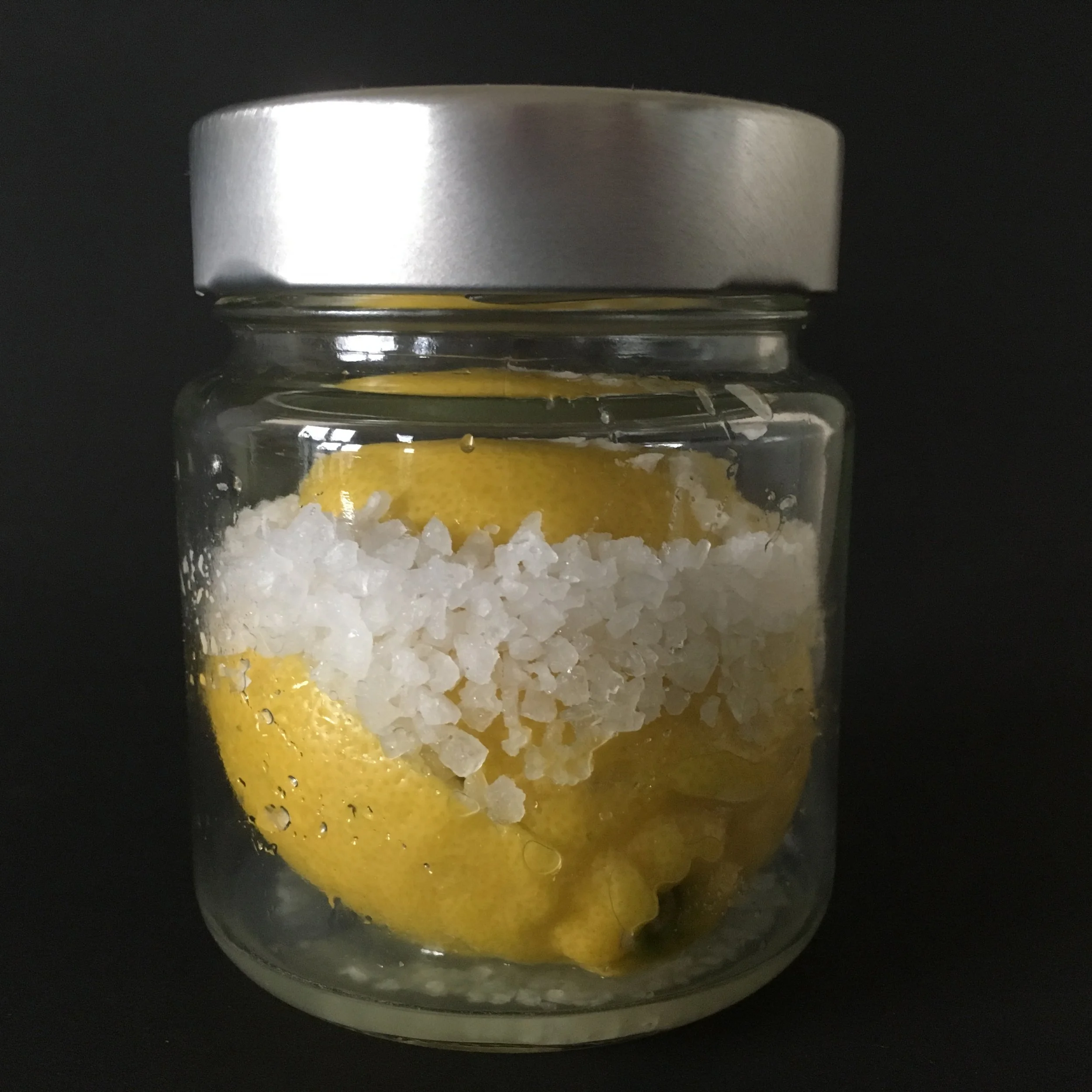Preserved lemons - when life gives you a leftover lemon
Lemons are such a versatile ingredient and seem to be so frequently used in most kitchens, it seems unlikely that you ever have any leftover. I find it does happen when I buy them in bulk. There is always one that I may not use immediately. And they do not keep for very long. Food storage tips often state that under no circumstances citrus fruit should ever be stored in the fridge. However I have found that they keep way longer when I do store them in the fridge. On the kitchen counter or in a fruit bowl they often start to grow mould within days. So I put them in the fridge as soon as I buy them. I just researched and was happy to find this comprehensive article on the Food52 website that confirmed my assumptions.
Cut the lemon lenghtways and crosswise but not right down to the bottom. Carefully stuff with one tablespoon of sea salt.
Food waste in my house (and I believe many will share this notion) often occurs due to indecision and procrastination. Luckily sometimes I remember that keeping it simple is key to a happier and more stressfree life. Preserved lemons are a good example of creating a stunning condiment with minimum effort. I have come across them nearly 20 years ago when I got a copy of Tamarind and Saffron by Claudia Roden. They are a staple ingredient in Morrocan cooking, especially used in tagines. With Middle Eastern cooking becoming increasingly prominent every year, more and more home cooks are getting acquainted with them. Claudia Roden featured several methods how to make them in the above mentioned book. I have only tried one so far, which I believe to remember she stated is the traditional one. I also find it the most fuss-free. The only thing you will need is a little bit of patience to let the lemons mature before you can use them in your cooking. But “what do you use them for apart from tagine?” some may ask. The skin can be chopped and used in grain salads, it is very good with fish dishes and stews, and my favourite way to use them is also a Claudia Roden recipe: roasted, skinned red peppers with preserved lemon skin, capers and a drizzle of pomegranate syrup. A divine starter, simple to prepare and very impressive.
The lemons need about 3-4 weeks to mature, then you can use the skin which by then will have become very tender. Most recipes using preserved lemons don’t mention uses for the brine and the flesh. They just ask you to use the skin and discard the rest. That is an awful lot of waste. The brine (made up of lemon juice and salt) and the flesh surely don’t have to be thrown. They are perfectly edible, maybe just not as intrigueing as the tender skin. My plan is to make this a serial post. First I would like you to follow this recipe and then we will explore more ways to use ALL parts of preserved lemons: skin, flesh and brine. Needless to say I am talking organic lemons here. Since you want to use the skin, you don’t want it to be full of pesticides.
Mostly when I make these, I prepare a larger jar with 3-4 lemons. But it is possible to make it with just one lemon. If you have one lemon sitting on your counter and feel indecisive how to use it, there you go. All you need is a jam jar and some sea salt. The jar should be large enough to accomodate the lemon, but not too big, because you don’t want it to float on top, it should stay underneath the brine. I will give the recipe for one lemon here. If you want to preserve more just use a larger jar and adjust the quantities accordingly. I usually use bottled lemon juice for the brine because then I feel safe to have enough to cover the lemons in the jar. Follow this blog and see what I will do with the skin in about 3-4 weeks.
Preserved lemon
1 organic lemon
1 tablespoon sea salt
lemon juice (freshly squeezed or bottled)
Cut the lemon vertically crosswise from the top down to the bottom. Don’t cut all the way through, you should stop about a centimetre (about half an inch) from the bottom. Gently pry the four quarters apart and fill with the salt. Some of the salt will fall out, but that’s not a problem. Put the salt-stuffed lemon into a sterilized jar (either washed in the dishwasher or rinsed with hot water then dried in the oven on a low temperature) and press it down. You can put the rest of the salt that has fallen out into the jar on top of the lemon. Close the jar and leave in the fridge for 3-4 days until the lemon has released some of it’s juices. Cover with lemon juice so that the lemon is fully covered. Close the jar and store in the fridge for 3-4 more weeks before using. The lemons will keep for months, but I find the skin gets softer and more brittle over time, losing some of it’s bite (which is not necessarily a bad thing).
Squeeze the lemon into a clean preserving jar large enough to hold it. Any salt that fell out you can add on top of the lemon.
After 4 days in the fridge the lemon has released some of its juices due to the salt. Now you need to top it up with some more juice.
The jar now has to be stored in the fridge for 3-4 weeks. Then the skin will be nice and tender. It keeps well for longer, however the skin will lose some of its bite and become more brittle.







